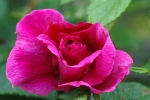This plant has the ‘hibiscus rosa-sinensis’ scientific name, with the common name of Chinese or Japanese Rose and the native home of China or India to Japan. The leaves are oval, spaced from place to place very highly colored green. With single flowers, double or beaten vigorous, shoots appear in the end. They are colored in red and lasts less, about 24 hours.

1. A frequency of watering:
Summer is very important that the soil should be constantly moist. Watering is done immediately after they surface layer appears dry. During flowering, roses need watering every day. To keep their leaves look healthy, but also for additional hydration is recommended to spray water on the leaves and to clean them every two days (only in warm periods).
Winter rest period is recommended. This means watering rare (once a week).
2. Ambient temperature:
Even if Japanese rose is a flower-loving light, temperature is more sensitive. For flowering plant it needs an ambient temperature not exceeding 20oC. Since the summer you can move the pot on the balcony or garden, you should choose a shaded area to protect the plant from heatstroke and sunburn.
Winter indicated that temperature is not less than 10oC, especially during sleep (when the watering is very rare). Even if your house temperature is higher, choose a shady sheltered spot and storage container. Avoid proximity to the radiator or any heat source aggressive, because the plant will dry out. The first sign is the yellowing of leaves.
3. Light intensity:
Light is the key to have full Japanese rose flowers. Without the light the plant will grow normally due to substrate and temperature, but will not form buds. It is better to sit the pot closer to the window, so the plant could receive light as a long period of days. If your home is well lit, you can get an artificial heating system.
In the late summer when the sun loses its power the plant can be exposed in full sun for ripening buds.
4. Works by correcting:
Although a flower Hibiscus Rosa is sensitive to environmental factors, it resists very well to cutting. Experts recommend that the cutting must be done once a year in the spring.
Correction works aimed at defining the shape of the crown. This will remove the branches and dry with very few leaves. The youth will be shortened as necessary to achieve a compact form of the crown.
If Rose gets a notice that the elongated shape do not develop at all in side, it is better to tip pinches. Thus the plant will adjust the height.
5. Quality substrate:
Roses will grow well in a mold and rich humus. If you can not find a special blend in stores, you can perform a combination of garden soil, ground leaves and sand.
During summer you can add liquid fertilizer soaked in water. Depending on the substrate qualities you should adjust the amount of fertilizer. You can plant the Japanese Rose in your garden if you want to achieve an Asian garden decor; even if it is not among the elements that describe the Asian garden, they can complement the atmosphere and give the space an authentic feel.
Japanese Rose Pictures Gallery



